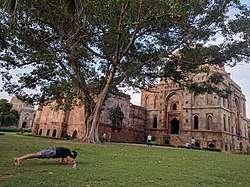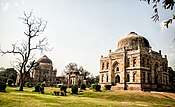Lodi Gardens
| Lodi Gardens | |
|---|---|
 The tomb of Muhammad Shah within the Lodi gardens | |
 Location within New Delhi | |
| Type | Public park |
| Location | New Delhi, India |
| Coordinates | Coordinates: 28°35′35″N 77°13′12″E / 28.593°N 77.220°E |
| Area | 90 acres (360,000 m2) |
| Status | Open year round |
Lodi Gardens or Lodhi Gardens is a city park situated in New Delhi, India. Spread over 90 acres (360,000 m2),[1] it contains, Mohammed Shah's Tomb, Tomb of Sikandar Lodi, Shisha Gumbad and Bara Gumbad,[2] architectural works of the 15th century by Lodis - who ruled parts of northern India and Punjab and Khyber Pakhtunkhwa province of modern-day Pakistan, from 1451 to 1526. The site is now protected by the Archaeological Survey of India (ASI).[1]

The gardens are situated between Khan Market and Safdarjung's Tomb on Lodhi Road and is a hot spot for morning walks for the Delhites.
History
The tomb of Mohammed Shah, the second last of the Sayyid dynasty rulers, the earliest of the tombs in the garden, was built in 1444 by Ala-ud-din Alam Shah as a tribute to Mohammed Shah. As there is little architecture from these two periods remaining in India, Lodi Gardens is an important place of preservation. The tomb of Mohammed Shah is visible from the road, and is the earliest structure in the gardens. The architecture is characterised by the octagonal chamber, with stone chhajjas on the roof and guldastas on the corners.
Another tomb within the gardens is that of Sikander Lodi, which is similar to Mohammed Shah's tomb, though without the chhatris, it was built by his son Ibrahim Lodi in 1517, the last of Sultan of Delhi from Lodi dynasty, as he was defeated by Babur, First battle of Panipat in 1526, this laying the foundation of the Mughal Empire. His tomb is often mistaken to be the Shisha Gumbad, and is actually situated in near the tehsil office in Panipat, close to the Dargah of Sufi saint Bu Ali Shah Qalandar. It is a simple rectangular structure on a high platform approached by a flight of steps. The tomb was renovated by the British, and an inscription mentioning Ibrahim Lodi's defeat at the hands of Babur and the renovation was included in 1866.[3][4] Under the Mughals major renovations would often take place depending on what occasions they would use the gardens for, under Akbar the Great the garden was used as an observatory and to keep records in a purpose built library.
In the centuries, after the 15th century Sayyid and Lodi dynasties, two villages grew around the monuments, but the villagers were relocated in 1936 in order to create the gardens. During British Raj, it was landscaped by Lady Willingdon, wife of Governor-General of India, Marquess of Willingdon, and hence named the 'Lady Willingdon Park' upon its inauguration on 9 April 1936,[5][6] and 1947, after Independence, it was given its present name, Lodi Gardens.

Later, it was re-landscaped in 1968 by J A Stein, who also designed the adjacent India International Centre, along with Garrett Eckbo,[7] during the time Stein also made a glasshouse within the park.[5][8] A British-period gateway, is still being used as an entrance that once welcomed visitors to 'Lady Willingdon Park'.
Since 2005, INTACH and Archaeological Survey of India (ASI) organise heritage walks for students and general public within the park area,[9] which has become a favorite with morning walkers and yoga enthusiasts. It is also a popular picnic spot for the residents of New Delhi. INTACH has made available a small booklet, offering information about park's history, and the monuments, birds and trees within the complex.[10] In 2009, Archaeological Survey of India (ASI) awarded the restoration project of five monuments with the garden in phases to and INTACH Delhi Chapter, starting with the Bara Gumbad, Shish Gumbad and Mohammed Shah's Tomb, after conservation report for the sites were being prepared since 2007. The MoU of the Rs 1 crore, first phase of the project funded by Steel Authority of India Ltd. (SAIL) was signed in 2005, initiating the process of conservation in which structural work began in 2009.[11][12]
Architecture
In the middle of the gardens is the Bara Gumbad ("Big Dome"), it consists of a large rubble-construct dome, it is not a tomb but a gateway to an attached a three domed masjid (mosque), both built in 1494 during the reign of Sikander Lodi, there is also a residence surrounding a central courtyard, where the remains of a water tank can be seen. Opposite the Bara Gumbad is the Shisha Gumbad ("Glass dome") for the glazed tiles used in its construction, which contains the remains of an unknown family, this was also built during the reign of Sikander Lodi.

Further into the gardens, are remains of a watercourse which connects the Yamuna River to Tomb of Sikandar Lodi. This tomb still has the battlements enclosing it. Nearby to Sikander's tomb is the Athpula ("Eight Piered") Bridge, the last of the buildings in Delhi, built during the reign of Mughal Emperor Akbar,[11] it contains seven arches, amongst which the central one being the largest. The tomb of Mohammed Shah, the last of the Sayyid dynasty rulers, the earliest of the tombs in the garden, was built in 1444 by Ala-ud-din Alam Shah as a tribute to Mohammed Shah. The tomb is octagonal in shape, with numerous ornamental Hindu-style chhatris around the central dome, numerous arches, verandahs and sloping buttresses. There are turrets at each corner. The main tomb is supported by a 16-sided drum. It is of a flattened type and is surrounded by chhatris, which make it look diminutive compared to its substantially larger base. Several years later, the Tomb of Sikandar Lodi seems to have been copied from this Sayyid tomb.[13]
As there is little architecture from these two periods remaining in India, Lodi Gardens is an important place of preservation. The tomb of Mohammed Shah is visible from the road, and is the earliest structure in the gardens. It is a good example of a combination of the Hindu and Islamic styles of architecture. The Hindu features include eight chhatris, each of them capped by a lotus finial with a decorative band around the base; corner ornamental pinnacles (guldastas)and chhajja.[14]
Gallery
 Shisha Gumbad, Lodi Gardens
Shisha Gumbad, Lodi Gardens%2C_Lodhi_Gardens%2C_Delhi.jpg) The three domed mosque, adjacent to Bada Gumbad, Lodi Gardens.
The three domed mosque, adjacent to Bada Gumbad, Lodi Gardens.- Sikander Lodi's tomb
- The eight piers bridge in Lodi gardens
 A duck stand beside the lake at Lodi Gardens
A duck stand beside the lake at Lodi Gardens Walled enclosure of the Sikander Lodi's Tomb
Walled enclosure of the Sikander Lodi's Tomb Shisha Gumbad in Front and Bara Gumbad with Mosque at back
Shisha Gumbad in Front and Bara Gumbad with Mosque at back The tomb of Mohammed Shah known as Mubarak Khan- Ka-Gumbaz
The tomb of Mohammed Shah known as Mubarak Khan- Ka-Gumbaz.jpg) Tomb of Sikandar Lodi Built 1494 A.D.
Tomb of Sikandar Lodi Built 1494 A.D.
See also
References
- 1 2 "ASI have included the remaining unprotected monuments of Lodhi Garden under the Delhi Circle protection umbrella". The Hindu. 16 October 2002.
- ↑ "Heritage walk marks 75th anniversary of Lodhi Garden".
- ↑ Tomb of Ibrahim Lodi Archived 14 May 2008 at the Wayback Machine.
- ↑ Ibrahim Lodi's Tomb
- 1 2 Lodi Gardens turns 70 The Hindu, 9 April 2006.
- ↑ Lodi Garden
- ↑ Eicher:City Guide – Delhi, Eicher Goodearth Publications. 1998. ISBN 81-900601-2-0. Page 117
- ↑ Walk with royalty Business Line, 23 February 2007.
- ↑ "Lodi Gardens Delhi's Oasis of calm". Indian Express. 9 October 2008.
- ↑ Walk by the green book in Lodi Gardens Indian Express, 22 March 2005.
- 1 2 SAIL to make Lodi Garden ‘stainless' The Times of India, Saurabh Sinha, TNN 14 August 2005.
- ↑ History gets a facelift The Times of India, Richi Verma, TNN 20 July 2009.
- ↑ Bhalla, A.S. Royal Tombs of India: 13th to 18th Century
- ↑ http://competentauthoritydelhi.co.in/MonumentViewer.aspx?ID=14
Further reading
- Sunday at the Lodi Gardens, by Vinay Dharwadker. Published by Viking, 1994.
- Lalkot to Lodi Gardens: (Delhi of Sultans), by Ranjit Sinha. Published by South Asia Books, 1996. ISBN 81-7167-237-X
External links
| Wikimedia Commons has media related to Lodi Gardens. |